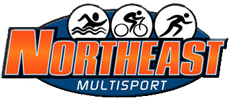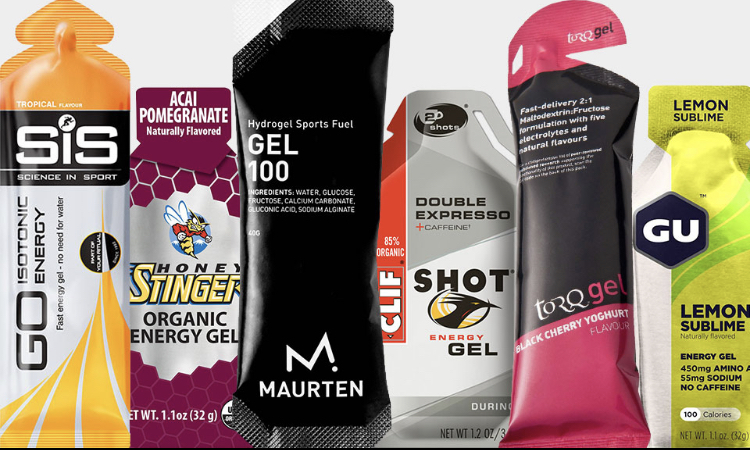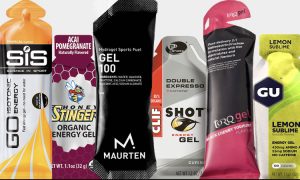 Fueling is considered to be the fourth discipline of triathlon and one thing is for sure, there is no lack of opinions on this topic.So how do you know what strategy is right for you?Step 1: Do Your Own Research! cialis cijenaThe number one favor you can do for yourself is to learn and understand the science behind how the human body reacts during endurance activities.There are all sorts of generic recommendations out there such as “Take salt capsules”, “Drink a water bottle an hour”, “Use real food”, “Use liquid fuel”, “Eat a gel every 45minutes”, etc.and although you may have great respect for the people giving you this advice, it is your body and your race so understanding the science behind
Fueling is considered to be the fourth discipline of triathlon and one thing is for sure, there is no lack of opinions on this topic.So how do you know what strategy is right for you?Step 1: Do Your Own Research! cialis cijenaThe number one favor you can do for yourself is to learn and understand the science behind how the human body reacts during endurance activities.There are all sorts of generic recommendations out there such as “Take salt capsules”, “Drink a water bottle an hour”, “Use real food”, “Use liquid fuel”, “Eat a gel every 45minutes”, etc.and although you may have great respect for the people giving you this advice, it is your body and your race so understanding the science behind 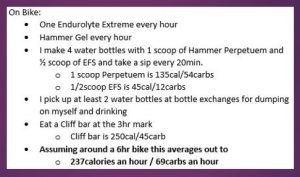 what is going on and why should be your first step in the process.There are several articles and books out there on fueling so find a trusted source (or two) and read up on it.Be sure to understand that the body’s needs change depending on the distance, the weather, your weight, your hydration level, and how far you are into the race.The book that gave me the greatest “A-ha” moment was “The Endurance Athlete’s Guide To Success” which was put out by Hammer Nutrition.And although the book does have some sales-pitchy parts around why you should choose their products over others, the reason I found this book so helpful is that it gives you the science and the math to calculate your own needs as well as what adjustments to make for different race day scenarios.After reading this book I was able to sit down with a pen and paper and calculate a comprehensive fueling strategy that is customized for my specific needs and my specific preference (which I put a picture of here to the right).Most importantly, knowing the science behind what is happening gives me the wherewithal and confidence to make any necessary corrections during my races to bring things back into line and prevent me from going on a tour-de-porta-potty the back half of the race.If you are interested, this book can be found for free online at: https://www.hammernutrition.com/media/downloads/fuelinghandbook.pdfStep 2: Read the LabelsThere are so many brands and types of fuel to choose from that it can be overwhelming.Instead of just going with the brand that most of your running buddies use or the brand they sell in your local running store or what your coach told you to use, put some thought into it yourself.Choose a brand and read the ingredient line.
what is going on and why should be your first step in the process.There are several articles and books out there on fueling so find a trusted source (or two) and read up on it.Be sure to understand that the body’s needs change depending on the distance, the weather, your weight, your hydration level, and how far you are into the race.The book that gave me the greatest “A-ha” moment was “The Endurance Athlete’s Guide To Success” which was put out by Hammer Nutrition.And although the book does have some sales-pitchy parts around why you should choose their products over others, the reason I found this book so helpful is that it gives you the science and the math to calculate your own needs as well as what adjustments to make for different race day scenarios.After reading this book I was able to sit down with a pen and paper and calculate a comprehensive fueling strategy that is customized for my specific needs and my specific preference (which I put a picture of here to the right).Most importantly, knowing the science behind what is happening gives me the wherewithal and confidence to make any necessary corrections during my races to bring things back into line and prevent me from going on a tour-de-porta-potty the back half of the race.If you are interested, this book can be found for free online at: https://www.hammernutrition.com/media/downloads/fuelinghandbook.pdfStep 2: Read the LabelsThere are so many brands and types of fuel to choose from that it can be overwhelming.Instead of just going with the brand that most of your running buddies use or the brand they sell in your local running store or what your coach told you to use, put some thought into it yourself.Choose a brand and read the ingredient line.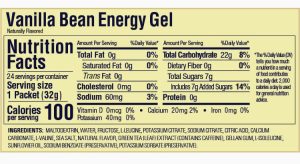 If it agrees with you and you don’t ever have any issues, you will know that those ingredients suit you. If you switch brands and suddenly have an issue, read the ingredient line and see what is different. Personally, fructose and honey cause GI issues for me so I steer clear of Honey Stinger products and GU products but I would never tell someone that those aren’t worth trying, especially since they are two very popular brands. Some people also steer clear of gels that contain caffeine for the same reasons. Just don’t put too much stock into blanket statements like “I don’t use xxx because it wrecked me during a race” or “xxx works on my bike but not on my run” or “I used to use xxx but then I had a bad experience with it so I switched” because what happened to them may not happen to you. Also, it could have been their level of dehydration or over-hydration that played the biggest role in that race falling apart for them and not the brand or the ingredients in it. So be sure to keep a log as well for your good and bad days. What was the temp/weather? What and how much had you drank and at what frequency? Was your caloric timing correct? This all plays a huge role in nailing down your fueling plan. So moral of the story: Just strive to be an informed athlete. Know what you are putting in your body, don’t take anyone else’s word for it, and if things go wrong (or very right), figure out why so you can learn from it.Step 3: Practice, Practice, PracticeOnce you have calculated your fuel/hydration/electrolyte needs and landed on a brand with a favorable ingredient line….PRACTICE IT!After all, you will never know until you try it.So no matter how long or how short your workout is, fuel for it following the same formula and logic you will be applying during your race.
If it agrees with you and you don’t ever have any issues, you will know that those ingredients suit you. If you switch brands and suddenly have an issue, read the ingredient line and see what is different. Personally, fructose and honey cause GI issues for me so I steer clear of Honey Stinger products and GU products but I would never tell someone that those aren’t worth trying, especially since they are two very popular brands. Some people also steer clear of gels that contain caffeine for the same reasons. Just don’t put too much stock into blanket statements like “I don’t use xxx because it wrecked me during a race” or “xxx works on my bike but not on my run” or “I used to use xxx but then I had a bad experience with it so I switched” because what happened to them may not happen to you. Also, it could have been their level of dehydration or over-hydration that played the biggest role in that race falling apart for them and not the brand or the ingredients in it. So be sure to keep a log as well for your good and bad days. What was the temp/weather? What and how much had you drank and at what frequency? Was your caloric timing correct? This all plays a huge role in nailing down your fueling plan. So moral of the story: Just strive to be an informed athlete. Know what you are putting in your body, don’t take anyone else’s word for it, and if things go wrong (or very right), figure out why so you can learn from it.Step 3: Practice, Practice, PracticeOnce you have calculated your fuel/hydration/electrolyte needs and landed on a brand with a favorable ingredient line….PRACTICE IT!After all, you will never know until you try it.So no matter how long or how short your workout is, fuel for it following the same formula and logic you will be applying during your race.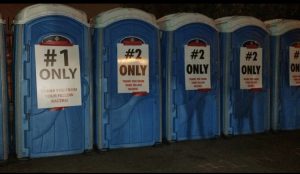 And aside from making sure your gut feels good, you want to make sure you have the logistics worked out. One NEMS’er, who will not be named, has one of the best fueling-fail stories I have heard. For whatever reason, he decided to switch to a flask for his gels versus the individual packet. He had never used this flask before but didn’t think much of it since it was the same brand he always used. Well, he found out the hard way during the bike portion of his 70.3 that the gel didn’t actually come out of the flask very easily and as a result, he wasn’t able to take in the calories he needed AND his bike and his hands were covered in gel from his fiddling with it so much. He was an absolute sticky mess during that hot summers day run!Also, there were some posts on the NEMS Facebook page a while back about people complaining about Ironman changing brands of Gatorade offered on course and as a result, several people had GI issues during the race that they attributed to that change.This post brought up some comments around “carry your own fuel”, “don’t depend on what is offered at the race”, etc.Again, there isn’t a one size fits all approach to this but it is something you need to figure out for yourself.If you are going to carry all of your own fuel, where do you plan to keep it?If you are stuffing it in back pockets and/or race belts is it comfortable to ride/run with?Is it easy to get to?Is the packaging easy to open without crashing your bike?These are all things you want to sort out during practice, not during the race!Step 4: Own It!
And aside from making sure your gut feels good, you want to make sure you have the logistics worked out. One NEMS’er, who will not be named, has one of the best fueling-fail stories I have heard. For whatever reason, he decided to switch to a flask for his gels versus the individual packet. He had never used this flask before but didn’t think much of it since it was the same brand he always used. Well, he found out the hard way during the bike portion of his 70.3 that the gel didn’t actually come out of the flask very easily and as a result, he wasn’t able to take in the calories he needed AND his bike and his hands were covered in gel from his fiddling with it so much. He was an absolute sticky mess during that hot summers day run!Also, there were some posts on the NEMS Facebook page a while back about people complaining about Ironman changing brands of Gatorade offered on course and as a result, several people had GI issues during the race that they attributed to that change.This post brought up some comments around “carry your own fuel”, “don’t depend on what is offered at the race”, etc.Again, there isn’t a one size fits all approach to this but it is something you need to figure out for yourself.If you are going to carry all of your own fuel, where do you plan to keep it?If you are stuffing it in back pockets and/or race belts is it comfortable to ride/run with?Is it easy to get to?Is the packaging easy to open without crashing your bike?These are all things you want to sort out during practice, not during the race!Step 4: Own It!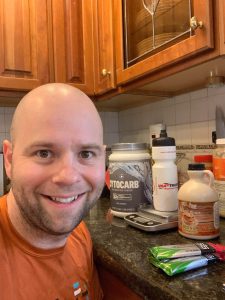 Let’s face it, there is so much to consider when it comes to fueling that we kind of overlook the fact that this stuff isn’t cheap! Gel packs alone can run you $1-$1.50 a piece and then by the time you add in other fueling powders, bars, capsules, post workout drinks, etc you could be spending $5-$10 a day on your long training days! So how does Jeremiah Stephens handle it? He makes his own! Jeremiah has been making his own “Maple Brew” for 2-3 years and was kind enough to share his process with us…”It started because it was cheaper.I’ve worked it out to about $1.13 for an hour of fuel.Sis gels (the brand I was using) would cost me a little over $3/hour.I do about half and half maltodextrin to maple syrup, or up to 2:1 malto/maple.Then I add one salt stick capsule per hour.I can do up to three hours in one bottle so in addition to it being cheap and easy to clean up, it’s also way easier to carry one bottle of fuel vs 2.5 gels per hour (the equivalent of 50-60grams of carbs).So when it comes to race day fueling, Salt N’ Pepa said it best….”Opinions are like @$$holes, everybody’s got one!” so do your own research, practice and figure out what works best for you, and be the master of your own race results!For a comprehensive list of what products are out there with a brief description of each check out this site shared by Jim Piper: https://www.triathlete.com/2019/02/nutrition/the-2019-triathlete-nutrition-buyers-guide_353557?utm_source=Triathlete&utm_campaign=2c45569af2-EMAIL_CAMPAIGN_2019_02_25_09_03&utm_medium=email&utm_term=0_6ac49db817-2c45569af2-79046537&mc_cid=2c45569af2&mc_eid=ee4c0701ea&fbclid=IwAR2ZcHLbhSVdw_UrKvjUFXtzlBAk10g-t9jcq4gh3vxGkRjCEJSepDrZGQA
Let’s face it, there is so much to consider when it comes to fueling that we kind of overlook the fact that this stuff isn’t cheap! Gel packs alone can run you $1-$1.50 a piece and then by the time you add in other fueling powders, bars, capsules, post workout drinks, etc you could be spending $5-$10 a day on your long training days! So how does Jeremiah Stephens handle it? He makes his own! Jeremiah has been making his own “Maple Brew” for 2-3 years and was kind enough to share his process with us…”It started because it was cheaper.I’ve worked it out to about $1.13 for an hour of fuel.Sis gels (the brand I was using) would cost me a little over $3/hour.I do about half and half maltodextrin to maple syrup, or up to 2:1 malto/maple.Then I add one salt stick capsule per hour.I can do up to three hours in one bottle so in addition to it being cheap and easy to clean up, it’s also way easier to carry one bottle of fuel vs 2.5 gels per hour (the equivalent of 50-60grams of carbs).So when it comes to race day fueling, Salt N’ Pepa said it best….”Opinions are like @$$holes, everybody’s got one!” so do your own research, practice and figure out what works best for you, and be the master of your own race results!For a comprehensive list of what products are out there with a brief description of each check out this site shared by Jim Piper: https://www.triathlete.com/2019/02/nutrition/the-2019-triathlete-nutrition-buyers-guide_353557?utm_source=Triathlete&utm_campaign=2c45569af2-EMAIL_CAMPAIGN_2019_02_25_09_03&utm_medium=email&utm_term=0_6ac49db817-2c45569af2-79046537&mc_cid=2c45569af2&mc_eid=ee4c0701ea&fbclid=IwAR2ZcHLbhSVdw_UrKvjUFXtzlBAk10g-t9jcq4gh3vxGkRjCEJSepDrZGQA
